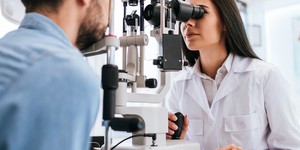Abstract
What is your favorite color and why? Do you think that simple tasks might be biased by your preferences? Find out in this science project if your color preferences will bias your fine motor skills when doing quick, repetitive tasks.Summary
Sara Agee, PhD, Science Buddies
M&M® and M&M's® are federally registered trademarks of Mars, Incorporated.
Objective
In this science project you will test whether color preference will affect repetitive tasks that require fine motor coordination, like picking up small objects very quickly.
Introduction
What does it mean to have a favorite color? It may be something that you choose for no good reason, other than the fact that you like it. You may have some kind of emotional reason for choosing a certain color. Can color preferences have biological origins?
When we see a color, it is interpreted in our brain by the visual cortex, where different groups of neurons are stimulated. The differential stimulation of neurons within the visual cortex might lead to color preferences. Do these preferences affect other brain functions, like our behavior?
Our brains also coordinate the movements of our muscles. This occurs in the motor cortex of the brain. If you play sports or video games, you know that one helpful skill is hand-eye coordination.This means that the different regions of your brain function well together, allowing you to be well-coordinated. When you catch a fast-moving ball, your eyes tell the brain where the ball is, then the brain tells your arm and hand to catch it.
If these two areas of the brain can coordinate complex movements and behaviors, then what other sensory responses can influence our behavior? In this science project, you will test how color can affect hand-eye coordination. You will ask participants to quickly choose different-colored M&M candies from a bowl. Will their choices reveal their color preferences?
Terms and Concepts
To do this type of science project, you should know what the following terms mean. Have an adult help you search the Internet or take you to your local library to find out more.
- Preference
- Hand-eye coordination
- Movement
- Bias
- Visual targeting
Questions
- How do preferences affect sudden choices, coordination, and movement?
- Will color preference influence the color of M&M's your participants pick up?
- Are visual targeting and hand-eye coordination biased by our color preferences?
Bibliography
- Murray, M.A. (n.d.). Our Sense of Sight: Part 3: Color Vision. Retrieved August 10, 2006.
- This site shows you how to make printable, color graphs of your data.
National Center for Education Statistics. (2006). Create a Graph. Retrieved April 30, 2008. - Johns Hopkins Medicine. (2014, January 21). Fast eye movements: A possible indicator of more impulsive decision-making. Science Daily. Retrieved October 16, 2014.
- American Demographics. (2002, February 1). Color by numbers -research data concerning color, demographic trends. The Medical Dictionary. Retrieved October 16, 2014.
Materials and Equipment
- Below are two ways you can perform this experiment and obtain accurate results.
- Buy 2 14-oz bags or 1 23.1-oz bag of M&M's and count out 50 of each color, then combine those in a bowl.
- Or go to a party store and buy 1 bag each of six different colors. Using a dry measuring cup, add 1/4 cup of each color to the bowl.
- Dry measuring cup (if you bought individually colored M&M's)
- Large bowl
- Several participants (at least 12)
- Sandwich baggies (one for each participant)
- Permanent markers
- Lab notebook
- Graph paper
Experimental Procedure
- Depending on which method you selected in the Materials and Equipment list, portion your M&M's into the large bowl.
- Ask your first participant to pick out M&M's as quickly as possible, using only a two-finger pinch, and with one arm behind his or her back. The participant should place them on the table next to the bowl as they are pulled out. As your participant puts them on the table, silently count the number of M&M's on the table. When you see that the participant has pulled out 20 M&M's, ask him or her to stop.
- Put the M&M's the first participant chose into a sandwich baggie. Ask the participant what his or her favorite color of M&M® is and write it on the baggie with a permanent marker.
- Replace the M&M's that the participant removed with the same-colored M&M's that the participant took from the bowl. For instance, if he or she removed three red and five dark brown M&M's, replenish the bowl with three red and five dark brown M&M's, not from the participant's sandwich baggie.
- Repeat steps 2 and 3 for all of your participants, replenishing the bowl with the same-colored M&M's as each participant removed after every trial.
- Be sure that you have written each participant's favorite color on every baggie! If you forgot to write this down, the data cannot be used and the contents must be disposed of.
- When you have collected data from several participants, sort your baggies into groups by the favorite color written on the baggies.
- Starting with one "Favorite Color" group, tally the numbers of each colored M&M in the bags. Then move on to the next "Favorite Color" and do another tally, until you have tallied the numbers of all of the colored M&M's picked for each "Favorite Color" category. Record your data in a data table in your lab notebook:
Favorite Color M&M Number of M&M's Chosen of Each Color Total Number of M&M 's Chosen Red Orange Yellow Green Blue Brown Red Orange Yellow Green Blue Brown - To be able to compare numbers between categories, you will need to normalize the data. Do this by calculating percentages of each color picked for each "Favorite Color" category. First add together the total number of M&Ms chosen for each "Favorite Color" in each row and insert that in your data table, like the one above. Then calculate the percentages in a new data table by dividing the number of M&M's chosen for a single color (from the Number of M&M's Chosen of Each Color column) by the total number of M&M's chosen (from the Total Number of M&M's Chosen column), and then multiplying your answer by 100. The new data table should look like this:
Favorite Color M&M Percentage of M&M's Chosen of Each Color Red Orange Yellow Green Blue Brown Red Orange Yellow Green Blue Brown - Now you want to find out if your participants chose their favorite color of M&M from the bowl more often than other colors. You can see this if you make a graph called a histogram for each "Favorite Color" M&M group. On the left side of the graph (y-axis), write a scale of percentages from zero to 100%. On the bottom of the graph (x-axis), write the series of M&M colors. Draw a bar for each color up to the matching percentage.
- Repeat step 10 for each of the favorite M&M colors. Did your participants tend to pick their favorite color?
Ask an Expert
Variations
In this science project, you tested a person's preference for color. There are many different preferences that you can test. Here are a few more ideas:
- Try this experiment to test biological characteristics that affect choice in small children. When shown two pictures of a boy and a girl, will a girl pick a girl and a boy pick a boy?
- Try this experiment to test how preference affects choice in small children. Ask a small child to choose a stuffed animal from a box of stuffed animals. Then ask what his or her favorite animal is. Record the data and count up the number of times they match.
- You can also try experiments to test mind-body coordination with handedness. Will people tend to use the same hand they write with to pick something up? Will people tend to step out first with the same side that they write with?
Careers
If you like this project, you might enjoy exploring these related careers:










